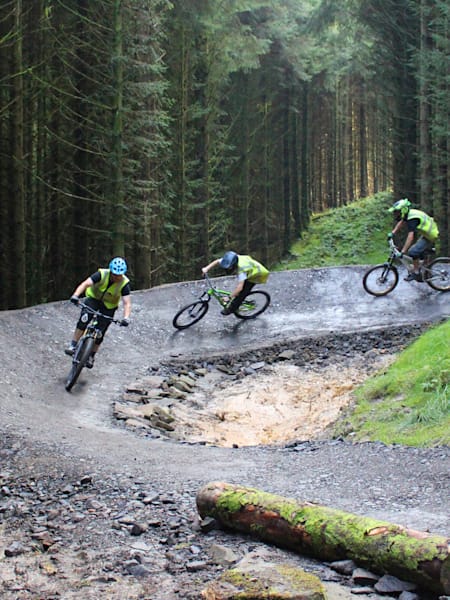Bike
Ever wondered how the trails in your local bike park were built, or what goes on behind the scenes when you’re not there? James Walker, Trail Crew Manager at Bike Park Wales – the UK’s first full-scale bike park – talks us through the process and shares his tips on how you can get involved.
Who designs the trails at Bike Park Wales?
Most of the trails are designed by Rowan Sorrell (a downhill racer and one of the park’s directors), as well as me and the rest of the trail crew. Rowan has been a leading force in trail design in the UK and beyond for more than 15 years, so he knows his stuff!
How does it all start?
With OS maps, a GPS and a pair of walking boots. We scout the hillsides for natural features that could be included – like boulder drops, bomb holes or chutes. Then we think about the character of the trail – is it going to be a machine-made trail, or more natural, challenging and technical? This also depends on the gradient and terrain. It takes imagination to visualise the trail, so we all pitch-in with our biking and trail building experience.
What happens next?
The information from the scouting stage is logged and used to create a plan. We decide everything from the grade to how long the trail will be. Each trail has to go through planning permission, so we submit a block of planned trails at once, then start developing them based on customer feedback and budget.
Do you use heavy equipment?
Lots of our trails are machine made, as there’s usually a lot of material to move, sculpt and shape. The machines depend on the scale of the job – we use anything from 1-tonne dumpers to 15-tonne machines for motocross-style jumps. Our trails are finished by hand. A few have been totally hand-built with shovels and mattocks – that’s as close as it gets to trail building in the traditional sense.
Are your crew employed full-time?
Our seven-strong trail crew are employed full-time, while we also work with external contractors for larger projects. The crew have a variety of backgrounds, from quantity surveying to construction and quarry workers.
The park prides itself on having well-maintained trails, and a full-time crew allows for that. The team concentrates on maintenance and improvements – we spend a lot of time spicing up old favorites, making significant improvements. This keeps the park fresh and exciting.
Do you come across many setbacks during the build?
Other challenges include water and ground type. We meticulously plan for drainage so trails can be ridden even in the wettest months. The ground on our mountain is very variable. We have pockets of golden dirt and mudstone (amazing for building and surfacing), then two metres later you’ll hit coal and boulder clay; that stuff ain’t so great!
There are limits to what you can build but this is all set out before construction begins. We’re conscious of the environment. Wildlife is thriving in the park and we do our best to keep the balance.
Who tests the trails?
We test the trails ourselves during construction, checking they’re fun as well as safe. A trail is ready when it’s been thoroughly tested and approved by myself and the directors.
What are the hardest features to build?
Large-scale jumps. It’s crucial to test these lots during the build to make sure the speed and style are right, which often leads to a bit of tweaking.
What’s your advice on wild trails – is it ok to build these anywhere?
Be aware of who owns the land. Wild trail building is a big part of mountain biking but you should get permission before you even enter the land, let alone start digging. There is a level of tolerance from forestry commissions but liability is a real issue. No one wants to be the ‘fun police’ but the last thing they want is someone to hurt themselves on their land while riding unofficial trails.
Is there anywhere we can get advice or get involved with trail building?
Most bike parks hold volunteer days, and have a local collective. At Bike Park Wales, we run around six volunteer weekends a year, where you can get involved and learn a thing or two. Our Facebook page Dig BikePark Wales is the best place to find out more.
I’d recommend helping out at your local trails, even just the once. You’ll get to see the effort and skill it takes, and there’s a great community spirit too. You’ll leave with a newfound appreciation for the trails you ride.
Finally, what’s your favourite trail at the park, and what’s new for 2017?
For me, a perfect combination is a summer evening uplift, a short-travel trail bike and the blue-graded Sixtapod. This is a flowing bike-park-style singletrack packed with berms and rollers that you can jump and gap. For 2017, we have at least one new trail opening imminently (more news on that soon) and plenty of planned development.








